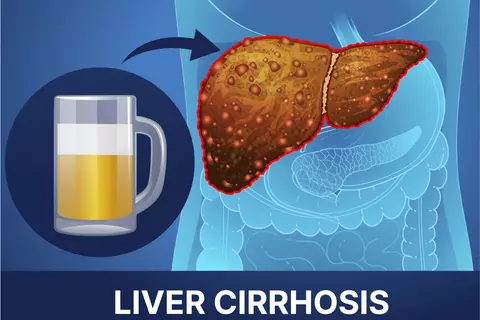Moderate alcohol consumption leads to a significantly increased risk of fibrosis in individuals with metabolic-associated liver disease
Marti-Aguado D et al, J Hepatol. 2024;81(6):930-940
This study examined 2 cohorts of individuals with metabolic-associated steatotic liver disease (MASLD) from Spain and the United States regarding their alcohol consumption. Even low amounts of alcohol consumption were associated with a significantly increased risk of significant liver fibrosis. In addition, the number of cardiovascular risk factors was associated with significant fibrosis.

Background and aims: Both metabolic dysfunction and alcohol consumption cause steatotic liver disease (SLD). The distinction between metabolic dysfunction-associated SLD (MASLD) and metabolic dysfunction-associated and alcohol-associated liver disease (MetALD) categories is based on arbitrary thresholds of alcohol intake. Thus, the authors assessed the impact of different levels of alcohol consumption on SLD severity and their interaction with metabolic comorbidities.
Methods: They performed a population-based study with transient elastography) data from participants in Spain (derivation cohort) and the US (validation cohort). A controlled attenuation parameter ≥ 275 dB/m was used to define SLD. At least one cardiometabolic risk factor was required to define MASLD. Among patients with MASLD, low alcohol consumption was defined as an average of 5–9 drinks/week, moderate consumption as 10–13 drinks/week for females and 10–20 drinks/week for males, and increased alcohol intake (MetALD) as 14–35 drinks/week for females and 21–42 drinks/week for males. Significant fibrosis was defined as a liver stiffness measurement ≥ 8 kPa and at-risk metabolic dysfunction-associated steatohepatitis (MASH) as a FAST score ≥ 0.35.
Results: The derivation cohort included 2227 individuals with MASLD (9% reported low, 14% moderate alcohol consumption) and 76 cases with MetALD. Overall prevalences of significant fibrosis and at-risk MASH were 7.6% and 14.8%, respectively. In the multivariable analysis, alcohol consumption was independently associated with significant fibrosis and at-risk MASH. A dose-dependent increase in the prevalence of significant fibrosis and at-risk MASH was observed between the number of drinks/week and the number of cardiometabolic factors. The validation cohort included 1732 participants with MASLD, of whom 17% had significant fibrosis and 13% at-risk MASH. This cohort validated the association between moderate intake and MASLD at risk of progression (odds ratio = 1.69, 95% confidence interval: 1.06–2.71).
Conclusions: Moderate alcohol intake is commonly seen in metabolic dysfunction-associated steatotic liver disease and increases the risk of advanced disease to a level similar to that observed in metabolic dysfunction-associated and alcohol-associated liver disease.